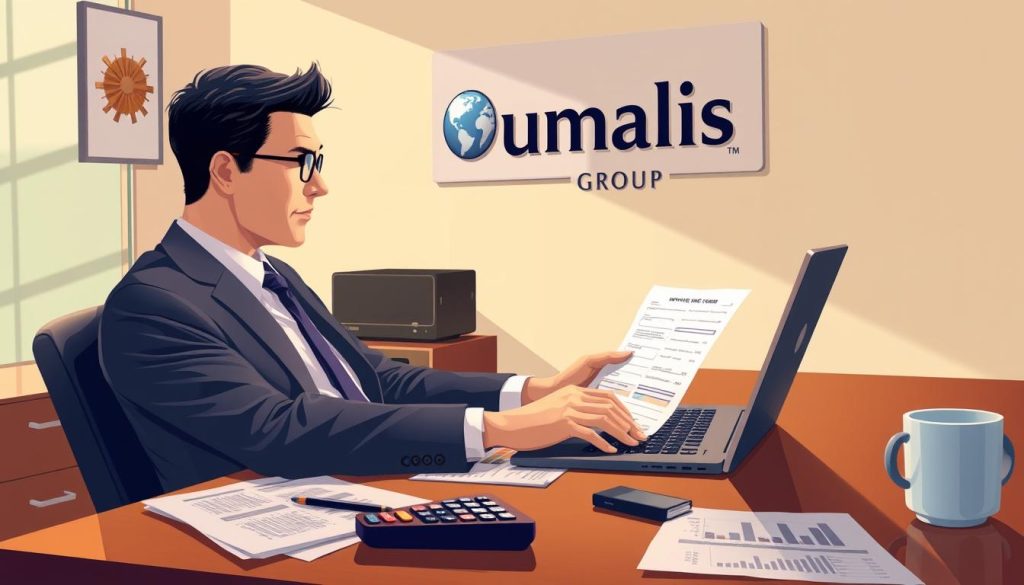Did you know 1 in 3 French professionals haven’t started planning financially for their post-career life? This gap in preparedness affects long-term stability, even in countries with robust pension systems. Building a secure future requires more than relying on state provisions—it demands strategic personal planning.
We’ve designed this guide to simplify complex financial concepts. Whether you’re self-employed or part of an organization, you’ll learn how to blend employer-sponsored programs with individual strategies. Our focus? Helping you create a tailored approach that adapts to your income, goals, and timeline.
Throughout this resource, we’ll compare tax-efficient vehicles like France’s PER (Plan d’Épargne Retraite) and international equivalents. You’ll gain clarity on balancing growth potential with risk management. By the end, you’ll know how to build a diversified portfolio that aligns with your vision of financial freedom.
Table of Contents
Key Takeaways
- Learn to evaluate employer-based plans versus personal investment accounts
- Understand tax advantages specific to French and cross-border solutions
- Discover strategies to balance short-term needs with long-term goals
- Gain tools to adjust your plan as career or life circumstances evolve
- Build confidence in making choices that prioritize security and growth
Understanding the Landscape of Retirement Savings
Strategic wealth-building demands more than sporadic contributions—it thrives on intentional design. Modern professionals face evolving markets where traditional pension systems meet innovative personal strategies. Let’s explore how structured planning transforms scattered efforts into cohesive growth.
Foundations of Wealth Building
Specialized accounts act as engines for financial growth, channeling funds into diversified assets. These portfolios blend stocks, bonds, and funds tailored to individual timelines. Early starters gain unmatched advantages: a €500 monthly investment at 25 could grow to €1.2M by 65 (7% annual return).
| Asset Type | Risk Level | Growth Potential | Time Horizon |
|---|---|---|---|
| Equities | High | 8-10% | 15+ years |
| Government Bonds | Low | 2-4% | 5-10 years |
| Mixed Funds | Moderate | 5-7% | 10-15 years |
Modern Approaches to Growth
Self-directed platforms now empower investors to customize allocations while maintaining tax efficiency. Compound growth turns consistent contributions into exponential results—doubling every decade at 7% returns. Younger professionals often allocate 80% to growth assets, shifting balance as milestones approach.
Recent data shows 63% of French investors under 40 prefer hybrid models combining employer plans with personal accounts. This flexibility helps navigate career changes while maintaining contribution momentum. Regular portfolio reviews ensure alignment with evolving life priorities.
Demystifying Individual PER and Its Benefits
Navigating financial tools for future security can feel overwhelming. France’s Individual PER simplifies this journey through adaptable structures designed for modern professionals. Let’s explore how this solution combines accessibility with strategic wealth-building.
Features and Eligibility
Available to all residents aged 18+, the Individual PER breaks barriers to entry. Whether you’re employed, self-employed, or between contracts, you can open an account through banks or insurers. This flexibility lets you compare fee structures and investment approaches across providers.
Tax Advantages and Transfer Opportunities
Contributions reduce your income tax burden immediately—up to 10% of professional earnings annually. For 2024, the maximum deductible amount reaches €34,424 for most taxpayers. Funds grow tax-deferred until withdrawal at retirement age, when they’re taxed as ordinary income.
| Contribution Type | Annual Limit | Tax Deduction |
|---|---|---|
| Standard Payments | €34,424 | 10% of income |
| Transfers from PERP | Unlimited | No new deduction |
| Employer Additions | +€5,232 | Separate allowance |
Managing Risks with Variable Investment Choices
Your PER adapts as your age and goals evolve. Early career stages might allocate 70% to equities, shifting toward bonds as milestones near. Providers offer pre-mixed portfolios or self-directed options for hands-on management.
Consolidate older plans like Madelin contracts into your PER for unified tracking. This transfer capability streamlines growth monitoring while maintaining existing tax benefits. Regular rebalancing ensures alignment with changing market conditions.
Comparing Investment Vehicles for Retirement
Choosing the right financial tools requires understanding how different structures serve distinct needs. Employer-sponsored programs and personal accounts each offer unique advantages—the key lies in aligning them with your career path and financial objectives.
Employer-Sponsored Plans vs. Independent Accounts
Company-backed solutions like 401(k)s provide immediate benefits through employer matches. « This matching contribution is essentially risk-free growth, » notes financial strategist Élise Martin. « If your company offers a 4% match, contributing less than that means leaving money on the table. »
However, these plans often limit investment choices to preselected funds. Independent accounts like IRAs counterbalance this by offering access to global markets and niche sectors. Self-employed professionals particularly benefit from this flexibility while maintaining tax efficiency.
| Feature | 401(k) | IRA |
|---|---|---|
| Contribution Limit (2024) | $23,000 | $7,000 |
| Employer Match | Yes | No |
| Investment Options | 15-30 funds | Unlimited |
Traditional IRAs, 401(k)s, and Beyond
Tax treatment varies significantly between vehicles. While 401(k) contributions reduce taxable income immediately, traditional IRAs offer similar deductions with broader portfolio control. High earners often combine both—maxing employer matches first, then directing surplus funds to personal accounts.
Recent reforms allow rollovers between certain plans without penalties. This interoperability helps professionals transitioning between employment types maintain contribution momentum. For tailored strategies, explore our guide to strategic retirement planning across career phases.
How Retirement Savings Options Impact Income Tax

Smart financial planning turns tax rules into growth tools rather than obstacles. We help you transform complex regulations into strategic advantages through informed account selection.
Immediate Relief vs. Future Freedom
Traditional accounts like 401(k)s lower your current taxable income through upfront deductions. A €10,000 contribution could save €3,000 immediately for someone in France’s 30% bracket. Funds grow tax-sheltered until withdrawal—ideal if you expect lower earnings later.
« Tax deferral isn’t just postponement—it’s compound growth’s best friend. Every euro not paid in taxes today works harder for decades. »
Roth alternatives flip this model. You pay taxes now but withdraw funds tax-free—critical if rates rise. Young professionals often benefit most, as decades of growth escape future levies.
| Account Type | Upfront Tax | Withdrawal Tax | Best For |
|---|---|---|---|
| Traditional | Deducted | Taxed | High current earners |
| Roth | Paid | Free | Growth-focused savers |
Blending both creates flexibility. Contribute to traditional accounts during peak earning years, then shift to Roth when income drops. This balance helps manage bracket jumps during your career transitions.
The Role of Employer Contributions and Pension Plans
Employer-backed financial programs serve as powerful accelerators for long-term security. Company-sponsored plans often include matching contributions—funds your employer adds to your account based on your own deposits. This creates instant growth: a 100% match on 5% of your salary effectively doubles your investment before market gains.
Traditional pension systems calculate payouts using a formula. Years of service and average salary determine your guaranteed income. For example, a worker earning €60,000 annually with 30 years at one company might receive €30,000 yearly (50% replacement). Employers manage all investment risks, shielding employees from market volatility.
« Maximizing employer matches isn’t optional—it’s foundational wealth-building. Failing to claim full matching funds is like declining a raise. »
Modern hybrid approaches blend pension stability with 401(k)-style flexibility. Many companies now offer both:
| Plan Type | Employer Role | Risk Responsibility |
|---|---|---|
| Defined Benefit | Full funding & management | Company |
| 401(k)/PERCO | Matching contributions | Employee |
To optimize benefits, contribute enough to trigger maximum matches first. Then assess how pension projections fit your broader financial strategy. Regular reviews ensure alignment as career paths evolve.
Optimizing Your Retirement Savings Options

Building lasting financial security requires a tactical sequence of actions, not just good intentions. Let’s explore how to strategically layer different plans to amplify growth while minimizing risks.
Maximizing Matching Contributions
Employer matches are non-negotiable wealth builders. If your company offers a 4% match on 401(k) deposits, contributing less forfeits free growth. For example, earning €50,000 annually, a full match adds €2,000 yearly—equivalent to a guaranteed 100% return before market gains.
| Priority | Action | Benefit |
|---|---|---|
| 1 | Secure full employer match | Instant ROI up to 100% |
| 2 | Maximize IRA contributions | Tax diversification |
| 3 | Return to employer plan | Higher annual limits |
Strategic Allocation between Various Plans
After securing matches, shift focus to IRAs. These accounts offer broader investment choices compared to employer-sponsored plans. A €7,000 annual IRA contribution grows tax-free (Roth) or tax-deferred (Traditional), complementing workplace benefits.
« Automating deposits across accounts ensures consistency. Treat these transfers like rent payments—non-negotiable and scheduled. »
Finally, revisit your employer plan to utilize its higher contribution limits. For 2024, you can allocate up to €23,000 to 401(k)s after maxing IRAs. This layered approach balances immediate tax savings with long-term flexibility.
Navigating Contributions, Limits, and Deductions
Understanding contribution rules unlocks opportunities to maximize your financial potential. Whether you’re part of an organization or self-managed, knowing annual thresholds ensures you leverage every tax-advantaged opportunity without overstepping boundaries.
Salaried Employees: Contribution Rules and Caps
For those with employer-sponsored plans, 2025 brings clear guidelines. Employee contributions cap at $23,500 annually, rising to $31,000 with catch-up provisions for workers aged 50+. These funds grow tax-deferred, reducing your current taxable income while building future reserves.
| Account Type | Under 50 | 50+ |
|---|---|---|
| IRA | $7,000 | $8,000 |
| 401(k)/Equivalent | $23,500 | $31,000 |
Independent Professionals: Special Considerations
Self-employed individuals calculate limits differently. Deductions typically align with 10% of net business earnings, ranging from €4,637 to €37,094 annually. « Track contributions quarterly, » advises tax consultant Antoine Moreau. « This prevents year-end surprises and optimizes deductible amounts across multiple income streams. »
Unused allowances from prior years can extend benefits. Carry forward unused limits for three years to compensate for lean periods. This flexibility helps maintain momentum during fluctuating income cycles.
Strategies for Early Withdrawals and Exit Planning
Planning your financial exit strategy requires balancing accessibility with long-term growth protection. While accessing funds before standard timelines carries penalties, life’s unpredictability sometimes demands flexibility. Let’s explore how to navigate these scenarios while preserving your financial foundation.
Identifying Qualifying Events for Early Release
French regulations permit penalty-free access under specific hardship conditions. These include permanent disability, home purchases, or business closure. For example, self-employed professionals can withdraw funds if ending their enterprise, while employees may qualify after prolonged unemployment.
Tax Implications and Withdrawal Methods
Early withdrawals typically incur a 10% penalty plus income tax. However, structured methods like SEPP payments (72(t) distributions) allow steady access without fines. After age 59½, penalties disappear—though ordinary taxes still apply. Post-72, required minimum distributions begin, calculated using IRS life expectancy tables.
Crafting a Smooth Transition into Retirement
Gradual phase-outs reduce reliance on lump sums. Consider partial withdrawals starting at retirement age, blending pension income with strategic account distributions. Partner with a financial planner to align withdrawal rates with lifestyle needs and market conditions.
Proactive planning transforms exit strategies from emergency measures into intentional transitions. By understanding qualifying events and tax implications, you maintain control over your financial future while adapting to life’s evolving demands.
FAQ
How do employer-sponsored plans differ from self-managed accounts?
Employer-sponsored options like 401(k)s often include matching contributions, while independent accounts such as IRAs offer broader investment flexibility. Both provide tax benefits but have distinct eligibility rules and contribution limits.
What tax advantages come with long-term financial planning tools?
Contributions to qualified plans may reduce taxable income, and earnings grow tax-deferred until withdrawal. Roth-style accounts allow tax-free growth if conditions are met, balancing immediate and future tax obligations.
Can independent professionals access employer-like pension benefits?
Yes. Solo 401(k)s or SEP IRAs let self-employed individuals contribute higher amounts, mimicking corporate plans. These tools help bridge gaps in employer-sponsored benefits while maintaining control over investments.
What happens if I withdraw funds before age 59½?
Early withdrawals typically incur a 10% penalty plus income taxes. Exceptions exist for qualifying events like medical emergencies or first-time home purchases, but planning minimizes unnecessary financial penalties.
How do variable investment options affect risk management?
Diversifying across stocks, bonds, and stable-value funds balances growth potential with security. Adjust allocations as you near your target age to protect accumulated capital from market volatility.
Are there income limits for contributing to tax-advantaged accounts?
Some plans like Roth IRAs phase out access at higher earnings levels. Traditional IRAs and 401(k)s have no income caps but may limit deductibility based on filing status and workplace coverage.
What strategies maximize employer matching programs?
Contribute at least enough to meet your employer’s full match threshold—it’s instant ROI. Prioritize this before funding secondary accounts to avoid leaving “free money” unclaimed.





